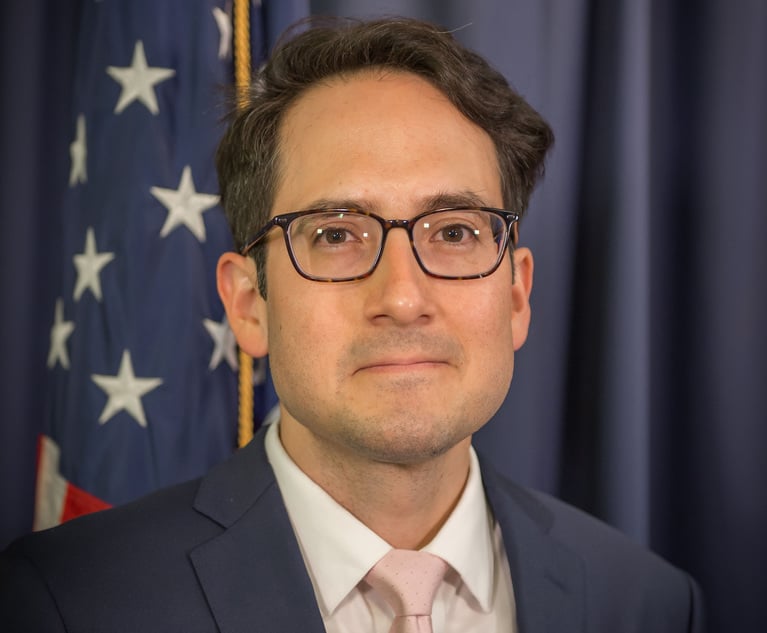Regulatory: A 2013 update on home health transactions
While the market continues to be faced with regulatory challenges, it is clear that Health and Human Services is increasingly focused on home health services.
October 09, 2013 at 05:00 AM
12 minute read
The original version of this story was published on Law.com
As we approach the three-year anniversary of the implementation of the “36-Month Rule” for home health transactions, it is a good time to review some of the ongoing and new issues in connection with the acquisition of home health agencies. Notwithstanding some of the regulatory hurdles that have arisen, the market for home health care services continues to be attractive, and consolidation appears to be a continuing trend.
While there are any number of current trends and issues that merit discussion, there are several that deserve special attention at this time.
1. Direct/Indirect transfers under the 36-month rule
Effective Jan. 1, 2011, the 36-month rule was implemented to avoid what the Centers for Medicare and Medicaid Services (CMS) believed was a problem in the home care market where parties were creating home health agencies and then quickly flipping them, resulting in Medicare provider agreements and billing privileges being transferred to buyers that might not meet the appropriate conditions of participation. While well intended, the rule has certainly limited potential sales, although careful planning can help to alleviate this issue.
For example, it is not uncommon in a consolidation transaction for the seller to have one or more HHAs that are either within 36 months of their initial enrollment with Medicare or that the seller has purchased pursuant to a change in majority ownership within the past 36 months. Either of these factors would trigger the application of the 36-month rule.
The rule, however, only applies to a change in direct ownership of the HHA, and not an indirect change. A careful planner will structure such transactions so that the change of ownership occurs on an indirect basis, such as by the use of a holding company. By having each HHA held in a separate subsidiary with a common holding company, the sale of the holding company will not trigger the application of the 36-month rule, even though one of the subsidiaries might have been purchased within the past 36 months.
A source of confusion has been the application of the traditional change of ownership rule for providers under Medicare Part A. The traditional rule provides that a change of ownership does not occur in a straight transfer of the corporate stock. This exception does not, however, apply to home health agencies covered by the 36-month rule. Consequently, the 36-month rule cannot be avoided by using a direct stock sale.
2. OIG Work Plan issues for 2013
The Office of Inspector General (OIG) published a Work Plan 2013 outlining a variety of issues related to home health services where it plans to increase regulatory focus. While these may not specifically impact a particular transaction, they should be considered as due diligence items that a purchaser may want to review as part of an acquisition.
Some of the more interesting parts of the Work Plan include the following:
- OIG believes that only 30 percent of home health services beneficiaries under Medicare have face-to-face encounters with the physician who ordered the home health services. Pursuant to the Affordable Care Act, these face-to-face encounters must occur within 120-day period beginning 90 days before the beneficiary starts home health care and ending 30 days after care begins. OIG has stated that they intend to monitor compliance with this new requirement.
- OIG intends to begin a program to determine compliance with state requirements that criminal background checks be conducted with respect to new employees of home health agencies. A previous OIG review found that 92 percent of nursing homes employed one individual with at least one criminal conviction.
- There will be an increased review of Outcome and Assessment Information Set (OASIS) data of home health agencies to determine if there is missing or incorrect patient outcome and assessment data. OIG is concerned that certain OASIS data is not being submitted and billing codes on Medicare clients may be inconsistent with OASIS data.
- In addition to Medicare, OIG will be conducting a wide variety of programs to ensure compliance with Medicaid. This will include a new program designed to determine the extent to which both Medicare and Medicaid have paid for the same home health services.
3. Due diligence items
While important in all transactions, proper diligence is key to acquisition of home health agencies, particularly where the transaction includes the assumption of Medicare provider agreements and billing privileges.
- State Licensure. Although not all states license home health agencies, many do; and understanding the transfer requirements and timeframes are crucial.
- Cash Management. One of the primary reasons for purchasers acquiring provider numbers and billing privileges is to avoid the short-term cash problem resulting from an inability to bill Medicare. Although entering into a sales-leaseback type transaction in order to continue to bill under the seller's provider number will help to solve the cash flow issues, it also creates potential liabilities to the buyer for any Medicare payment obligations and potential penalties that might arise due to activities of the seller prior to transfer. In these types of transactions, it is important that the buyer receive full indemnities and conduct specific due diligence into the seller's history and activities.
- Restrictive Covenants. Due to the fact that home health remains a market with relatively low barriers to entry, the due diligence review should include an assessment of the risk that any of the sellers or its employees might be in a position to open a competitive agency. Although state laws on enforceability of restrictive covenants vary widely throughout the country, buyers should consider the appropriateness of restrictive covenants.
- OIG Review. As described above, the 2013 OIG Work Plan has a variety of initiatives specific to home health. Buyers may want to review the Work Plan to identify those areas of particular interest to the OIG as part of their due diligence investigation.
While the market continues to be faced with regulatory challenges, and the full impact of the Affordable Care Act remains to be seen, it is clear that Health and Human Services, as well as OIG, is increasingly focused on home health services. As the market expands, consolidation continues, and the amount of dollars spent on home health services under Medicare continues to increase, it is likely that regulatory attention will put increased pressure on buyers to understand the risks that they are assuming in the acquisition process.
As we approach the three-year anniversary of the implementation of the “36-Month Rule” for home health transactions, it is a good time to review some of the ongoing and new issues in connection with the acquisition of home health agencies. Notwithstanding some of the regulatory hurdles that have arisen, the market for home health care services continues to be attractive, and consolidation appears to be a continuing trend.
While there are any number of current trends and issues that merit discussion, there are several that deserve special attention at this time.
1. Direct/Indirect transfers under the 36-month rule
Effective Jan. 1, 2011, the 36-month rule was implemented to avoid what the Centers for Medicare and Medicaid Services (CMS) believed was a problem in the home care market where parties were creating home health agencies and then quickly flipping them, resulting in Medicare provider agreements and billing privileges being transferred to buyers that might not meet the appropriate conditions of participation. While well intended, the rule has certainly limited potential sales, although careful planning can help to alleviate this issue.
For example, it is not uncommon in a consolidation transaction for the seller to have one or more HHAs that are either within 36 months of their initial enrollment with Medicare or that the seller has purchased pursuant to a change in majority ownership within the past 36 months. Either of these factors would trigger the application of the 36-month rule.
The rule, however, only applies to a change in direct ownership of the HHA, and not an indirect change. A careful planner will structure such transactions so that the change of ownership occurs on an indirect basis, such as by the use of a holding company. By having each HHA held in a separate subsidiary with a common holding company, the sale of the holding company will not trigger the application of the 36-month rule, even though one of the subsidiaries might have been purchased within the past 36 months.
A source of confusion has been the application of the traditional change of ownership rule for providers under Medicare Part A. The traditional rule provides that a change of ownership does not occur in a straight transfer of the corporate stock. This exception does not, however, apply to home health agencies covered by the 36-month rule. Consequently, the 36-month rule cannot be avoided by using a direct stock sale.
2. OIG Work Plan issues for 2013
The Office of Inspector General (OIG) published a Work Plan 2013 outlining a variety of issues related to home health services where it plans to increase regulatory focus. While these may not specifically impact a particular transaction, they should be considered as due diligence items that a purchaser may want to review as part of an acquisition.
Some of the more interesting parts of the Work Plan include the following:
- OIG believes that only 30 percent of home health services beneficiaries under Medicare have face-to-face encounters with the physician who ordered the home health services. Pursuant to the Affordable Care Act, these face-to-face encounters must occur within 120-day period beginning 90 days before the beneficiary starts home health care and ending 30 days after care begins. OIG has stated that they intend to monitor compliance with this new requirement.
- OIG intends to begin a program to determine compliance with state requirements that criminal background checks be conducted with respect to new employees of home health agencies. A previous OIG review found that 92 percent of nursing homes employed one individual with at least one criminal conviction.
- There will be an increased review of Outcome and Assessment Information Set (OASIS) data of home health agencies to determine if there is missing or incorrect patient outcome and assessment data. OIG is concerned that certain OASIS data is not being submitted and billing codes on Medicare clients may be inconsistent with OASIS data.
- In addition to Medicare, OIG will be conducting a wide variety of programs to ensure compliance with Medicaid. This will include a new program designed to determine the extent to which both Medicare and Medicaid have paid for the same home health services.
3. Due diligence items
While important in all transactions, proper diligence is key to acquisition of home health agencies, particularly where the transaction includes the assumption of Medicare provider agreements and billing privileges.
- State Licensure. Although not all states license home health agencies, many do; and understanding the transfer requirements and timeframes are crucial.
- Cash Management. One of the primary reasons for purchasers acquiring provider numbers and billing privileges is to avoid the short-term cash problem resulting from an inability to bill Medicare. Although entering into a sales-leaseback type transaction in order to continue to bill under the seller's provider number will help to solve the cash flow issues, it also creates potential liabilities to the buyer for any Medicare payment obligations and potential penalties that might arise due to activities of the seller prior to transfer. In these types of transactions, it is important that the buyer receive full indemnities and conduct specific due diligence into the seller's history and activities.
- Restrictive Covenants. Due to the fact that home health remains a market with relatively low barriers to entry, the due diligence review should include an assessment of the risk that any of the sellers or its employees might be in a position to open a competitive agency. Although state laws on enforceability of restrictive covenants vary widely throughout the country, buyers should consider the appropriateness of restrictive covenants.
- OIG Review. As described above, the 2013 OIG Work Plan has a variety of initiatives specific to home health. Buyers may want to review the Work Plan to identify those areas of particular interest to the OIG as part of their due diligence investigation.
While the market continues to be faced with regulatory challenges, and the full impact of the Affordable Care Act remains to be seen, it is clear that Health and Human Services, as well as OIG, is increasingly focused on home health services. As the market expands, consolidation continues, and the amount of dollars spent on home health services under Medicare continues to increase, it is likely that regulatory attention will put increased pressure on buyers to understand the risks that they are assuming in the acquisition process.
This content has been archived. It is available through our partners, LexisNexis® and Bloomberg Law.
To view this content, please continue to their sites.
Not a Lexis Subscriber?
Subscribe Now
Not a Bloomberg Law Subscriber?
Subscribe Now
NOT FOR REPRINT
© 2025 ALM Global, LLC, All Rights Reserved. Request academic re-use from www.copyright.com. All other uses, submit a request to [email protected]. For more information visit Asset & Logo Licensing.
You Might Like
View All
GOP Now Holds FTC Gavel, but Dems Signal They'll Be a Rowdy Minority
6 minute read
Trump's Inspectors General Purge Could Make Policy Changes Easier, Observers Say

Keys to Maximizing Efficiency (and Vibes) When Navigating International Trade Compliance Crosschecks
6 minute read
Crypto Industry Eyes Legislation to Clarify Regulatory Framework
Trending Stories
- 1McCarter & English Adds Outgoing U.S. Attorney
- 2Chinese Firms Hire Partners from Kirkland and Paul Hastings in Hong Kong
- 3'He Used Some Colorful Language': Yale Defamation Case Survives
- 4Man Charged in Daylong Shooting Rampage in Memphis Is Serving as His Own Lawyer
- 5Counterpoint: FLA Is Committed To the Success of Legal Professionals
Who Got The Work
J. Brugh Lower of Gibbons has entered an appearance for industrial equipment supplier Devco Corporation in a pending trademark infringement lawsuit. The suit, accusing the defendant of selling knock-off Graco products, was filed Dec. 18 in New Jersey District Court by Rivkin Radler on behalf of Graco Inc. and Graco Minnesota. The case, assigned to U.S. District Judge Zahid N. Quraishi, is 3:24-cv-11294, Graco Inc. et al v. Devco Corporation.
Who Got The Work
Rebecca Maller-Stein and Kent A. Yalowitz of Arnold & Porter Kaye Scholer have entered their appearances for Hanaco Venture Capital and its executives, Lior Prosor and David Frankel, in a pending securities lawsuit. The action, filed on Dec. 24 in New York Southern District Court by Zell, Aron & Co. on behalf of Goldeneye Advisors, accuses the defendants of negligently and fraudulently managing the plaintiff's $1 million investment. The case, assigned to U.S. District Judge Vernon S. Broderick, is 1:24-cv-09918, Goldeneye Advisors, LLC v. Hanaco Venture Capital, Ltd. et al.
Who Got The Work
Attorneys from A&O Shearman has stepped in as defense counsel for Toronto-Dominion Bank and other defendants in a pending securities class action. The suit, filed Dec. 11 in New York Southern District Court by Bleichmar Fonti & Auld, accuses the defendants of concealing the bank's 'pervasive' deficiencies in regards to its compliance with the Bank Secrecy Act and the quality of its anti-money laundering controls. The case, assigned to U.S. District Judge Arun Subramanian, is 1:24-cv-09445, Gonzalez v. The Toronto-Dominion Bank et al.
Who Got The Work
Crown Castle International, a Pennsylvania company providing shared communications infrastructure, has turned to Luke D. Wolf of Gordon Rees Scully Mansukhani to fend off a pending breach-of-contract lawsuit. The court action, filed Nov. 25 in Michigan Eastern District Court by Hooper Hathaway PC on behalf of The Town Residences LLC, accuses Crown Castle of failing to transfer approximately $30,000 in utility payments from T-Mobile in breach of a roof-top lease and assignment agreement. The case, assigned to U.S. District Judge Susan K. Declercq, is 2:24-cv-13131, The Town Residences LLC v. T-Mobile US, Inc. et al.
Who Got The Work
Wilfred P. Coronato and Daniel M. Schwartz of McCarter & English have stepped in as defense counsel to Electrolux Home Products Inc. in a pending product liability lawsuit. The court action, filed Nov. 26 in New York Eastern District Court by Poulos Lopiccolo PC and Nagel Rice LLP on behalf of David Stern, alleges that the defendant's refrigerators’ drawers and shelving repeatedly break and fall apart within months after purchase. The case, assigned to U.S. District Judge Joan M. Azrack, is 2:24-cv-08204, Stern v. Electrolux Home Products, Inc.
Featured Firms
Law Offices of Gary Martin Hays & Associates, P.C.
(470) 294-1674
Law Offices of Mark E. Salomone
(857) 444-6468
Smith & Hassler
(713) 739-1250






